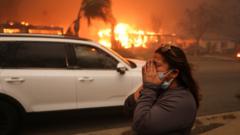As the planet grapples with a climate crisis, a recent study has disclosed a staggering rise in atmospheric carbon dioxide (CO2) levels, surpassing all prior records. This concerning trend poses a serious threat to global climate goals established under the 2015 Paris Agreement, particularly the commitment to limit warming to 1.5°C above pre-industrial levels.
Last year, CO2 concentrations increased by nearly 3.6 parts per million (ppm), reaching over 424ppm. This data, sourced from Mauna Loa Observatory—a key site for monitoring atmospheric gases—highlights the highest yearly increase since measurements began in 1958.
Experts attribute the rise primarily to record fossil fuel emissions, which intensified due to a combination of human activity, wildfires, and drought conditions. The natural world has historically played a role in absorbing roughly half of humanity's emissions; however, recent events, including the El Niño phenomenon, have diminished this capacity significantly.
The increase in greenhouse gas levels brings dire implications for climate stability, with the UK’s Met Office emphasizing that current trends are "incompatible" with limiting global warming to 1.5°C. Indeed, 2024 has been confirmed as the hottest year on record, a stark indication that we are venturing into uncharted climatic territory at an alarming pace.
Climate experts, including Richard Betts of the Met Office, express grave concerns regarding the long-term implications of these rising CO2 levels, which are now more than 50% higher than pre-industrial times. With predictions suggesting continued increases in emissions, the pathway to achieving climate targets becomes increasingly tenuous.
Moreover, the natural world faces additional threats from rampant wildfires, particularly in the Arctic and Amazon, which are becoming less effective as carbon sinks. Vegetation is struggling to sequester carbon at a time when it is needed most, and experts underscore that maintaining the planet’s carbon balance will require thorough monitoring and urgent action.
While some forecasts indicate that the CO2 concentration may see a slight decline in 2025, long-term warming trends are expected to persist as carbon builds in the atmosphere. The UN emphasizes that immediate measures are vital to avert catastrophic consequences.
With record emission levels pushing the planet beyond critical climate thresholds, the urgency for comprehensive and effective climate policies could not be clearer. The global community must rally to ensure that the ambitious targets set forth at the Paris Agreement still hold merit against an increasingly warming world.

















